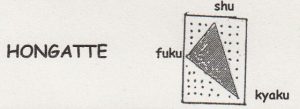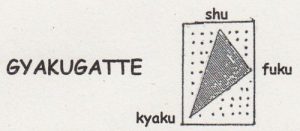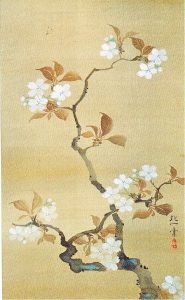Position on the right/hongatte and position on the left/gyakugatte.
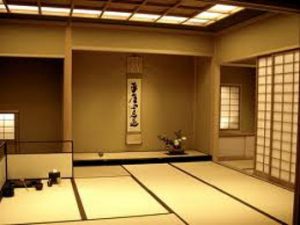 |
Ikebana was born in the 15th century in and with the tokonoma, the “sacred” and empty space of the traditional Japanese home, and the composition was placed to the right or to the left of the kakemono representing Buddha, in the adjacent photo it is placed to the left of the kakemono. It was only from the 1930s onwards that ikebana began to be placed outside the tokonoma. |
At that time, (see art. 13°) it was customary to arrange the plants exclusively with the main element in a vertical position and in the middle of the composition. This approach corresponds broadly to the current Chokuritsu-kei of the Ohara School. There were therefore two possibilities for the placement of the three elements that the Ohara School calls Shu-shi; Fuku-shi and Kyaku-shi.
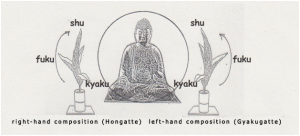
For this reason, the two types of composition – characterized by the different relationship of the three main elements – were called right-handed, the one to the right of the kakemono representing Buddha, and left-handed, the one to its left.
It is important to emphasize that the right or left we are talking about is not the one referring to the person looking at the composition but the one referring to the most important element of the tokonoma, which is the kakemono. See art. 17)
With the time going by, the kakemono – which originally only represented Buddha – was first replaced by other religious characters and then became extended to secular ones, landscapes or drawings of any subject or phrases said by famous people, but it maintained its “sacredness” and remained the most important element of the tokonoma.
The terms left and right were retained even when the composition was removed from the tokonoma as it indicates the internal position/relationship within the composition between its three main elements.
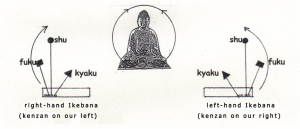
Based on this concept used since the birth of ikebana, the Ohara School defines “right-side” or “left-side” moribana because of the position of the kenzan placed along the bisecting line of the vase.
Imagining a Buddha in the center of the vase and in relation to this the composition is right if to the right of the Buddha or vice versa. In the heika, we rely on the point of spread to the right or left of the mouth of the vase. We have seen that the term right side and left side (also called hongatte and gyakugatte) refers to an exterior element (Buddha) with respect to which ikebana is placed either to its right or left. However, this denomination also expresses the relationship within the composition between its three main elements Shu-shi; Fuku-shi and Kyaku-shi y (Yaku-eda of the Ohara School) See art. 16 and 17.
The right-handed arrangement is the most frequently performed: in Japan, too, the majority of the population is right-handed and this makes it easier to perform the right-handed arrangement, while left-handed people, who are in the minority, find it easier to perform the left-handed arrangement. This is why the right side composition is called HON-GATTE which means “katte= gate=normal and hon= situation”, considered as such because it is “most frequently performed”, believing that what the majority of people do is “the normality”. The left-hand composition is called gyaku-gatte because it is the opposite of the situation that is most frequently performed (gyaku= opposite).
In the kenzan, the scalene triangle formed by the insertion points of the plants in a hongatte composition is “mirror-like” to the triangle formed by the insertions of the plants in a gyakugatte composition.
Insertion points of the main elements in the kenzan in the Chokuritsu- kei in the Ohara School.
Insubstantiality, along with impermanence, is one of the basic pillars of Buddhism, the symbols of which we find in the rules of ikebana composition.
In ikebana, this concept of being in harmonic concordance with one’s surroundings is “putting into practice” the Buddhist concept of insubstantiality (every entity is always and necessarily made up of relationships, both on a biological and ethical level).
The compositions of the Ohara school based on a style (kei On-reading or kata Kun-reading) placed outside the tokonoma will be positioned in this way following what would have been their position in the tokonoma in relation to the kakemono, resulting also in coherence with their name (right or left).
The compositions of the Ohara school based on a style (kei On-reading or kata Kun-reading) placed outside the tokonoma will be positioned in this way following what would have been their position in the tokonoma in relation to the kakemono, resulting also in coherence with their name (right or left).
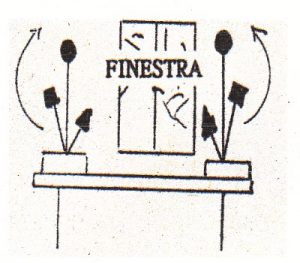
A hongatte (right-handed) composition will be placed to the right of an element with which it must match (painting, window, chimney, etc.) while if it is placed to its left it will be a gyakugatte (left-handed) composition; here are some examples:
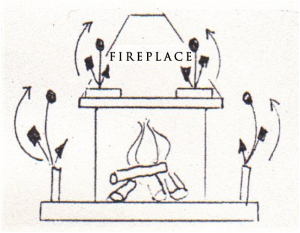
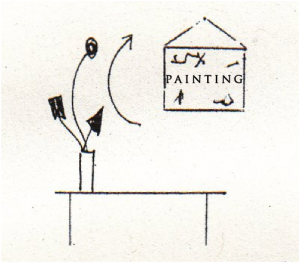
Please note:
In keeping with the current trend to simplify the rules and teaching of ikebana, since 2015 the Ohara School only uses the expression hongatte and gyakugatte and no longer the equivalent terms of right-hand or left-hand (see articles 16 and 17),
because these terms create some confusion in ikebanists of western culture who take as their reference point the right and left of the beholder, whereas in ancient Japan the right and left is not that of the beholder but that of a more important person (or object) on whose right or left side the element being considered is located. See Article 17



